Last Updated: 2 years ago
Cats are one of the most beloved pets around, and we want to give them only the best.
One common question that comes up for cat owners is ‘can cats eat shrimp?’
It’s a valid concern – after all, you don’t want to accidentally cause your pet harm!
We’ll take an in-depth look at whether or not it’s safe for cats to consume shrimp.
Also, we’ll provide tips on how to safely introduce shrimp into their diet so that you can make sure they’re getting all the nutrition they need without any unwanted side effects.
Nutritional Benefits of Shrimp for Cats
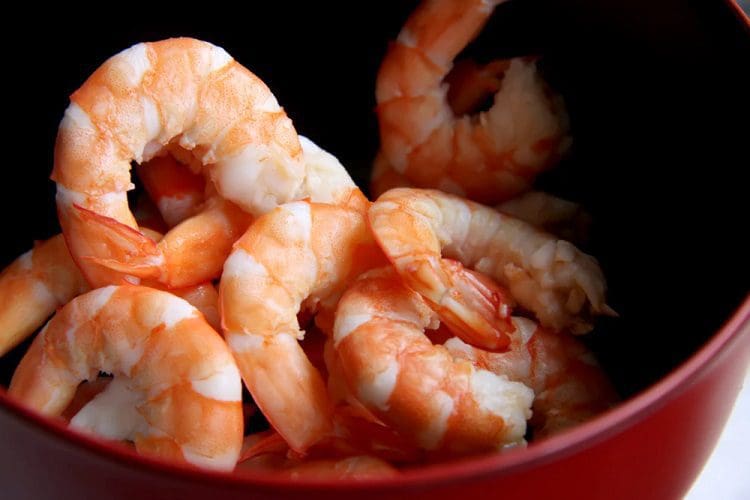
Shrimp is a great source of nutrition for cats. It contains high levels of protein, omega-3 fatty acids, and vitamins and minerals that can help keep your cat healthy.
Shrimp can be a nutritious addition to your cat’s diet if it is prepared properly.
With careful preparation, you can give your feline friend all the nutritional benefits this tasty treat has to offer.
Here are some of the nutritional benefits shrimp can provide to cats:
Protein Content
Shrimp is an excellent source of lean protein for cats. Protein helps build muscle mass and supports overall health in cats.
One 3-ounce serving of cooked shrimp provides approximately 20 grams of protein – more than one-third the daily recommended amount for an average adult cat.
Omega-3 Fatty Acids
Omega-3 fatty acids are essential nutrients that play a role in maintaining healthy skin and coat as well as supporting joint health in cats.
Shrimp is a good source of these beneficial fats, providing about 1 gram per 3 ounces when cooked.
Vitamins and Minerals
In addition to being rich in proteins and omega-3s, shrimp also contains several important vitamins and minerals such as zinc, selenium, phosphorus, vitamin B12, niacin (vitamin B3), choline (vitamin B4) and riboflavin (vitamin B2).
These micronutrients support many bodily functions including digestion, immunity function and energy production in cats.
Potential Risks of Feeding Shrimp to Cats

Shrimp can be a nutritious addition to your cat’s diet, but there are some potential risks associated with feeding them shrimp.
Allergies are the most common risk when it comes to introducing new foods into your cat’s diet.
If you notice any signs of an allergic reaction such as vomiting, diarrhea, or skin irritation after feeding your cat shrimp, discontinue use immediately and consult with your veterinarian.
Contamination with heavy metals and bacteria is another risk associated with feeding shrimp to cats.
It is important to purchase high-quality seafood from reputable sources in order to reduce the chances of contamination.
Make sure that the shrimp have been cooked properly before serving it to your cat in order to kill off any harmful bacteria that may be present on the surface of the food.
Overfeeding is also a concern when it comes to feeding shrimp to cats due its high-fat content and calorie density.
Shrimp should only make up a small portion of your cat’s overall diet – no more than 10% – as too much can lead to weight gain and other health issues over time.
It is important not to exceed recommended daily allowances for protein intake when adding this type of food into their meals as well.
How to Prepare Shrimp for Your Cat
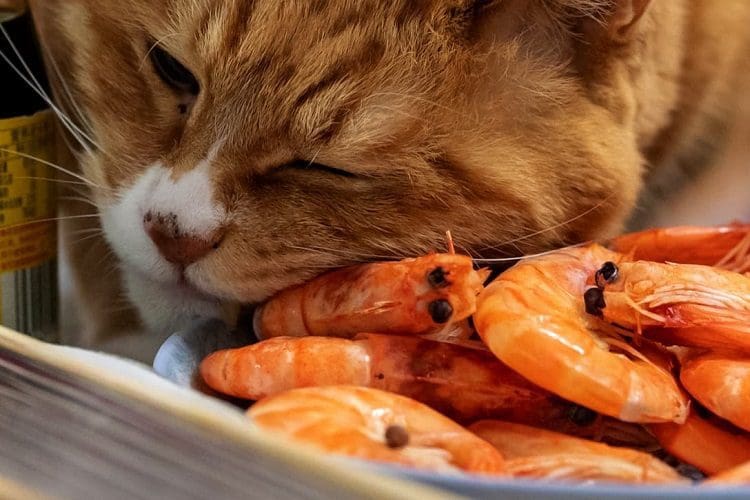
When it comes to preparing shrimp for your cat, there are a few important steps you should take.
Choosing the right type of shrimp is key; look for wild-caught varieties that have been sustainably harvested and free from any additives or preservatives.
Cleaning and cooking the shrimp properly is also essential; make sure to rinse them thoroughly in cold water before boiling or steaming them until they turn pink.
Consider serving size when feeding your cat shrimp as a treat; start with small amounts at first and monitor their reaction closely before increasing the portion size.
Choosing the Right Type of Shrimp
It’s best to select wild-caught varieties that have been sustainably harvested and free from any additives or preservatives.
Look for labels like “sustainably caught” or “responsibly farmed” on packages of frozen seafood so you can be sure you’re getting quality ingredients for your pet.
You may also want to check with local fishmongers who often carry fresh seafood options that meet these standards as well.
Cleaning and Cooking the Shrimp Properly
Always rinse them thoroughly in cold water before boiling or steaming until they turn pink – this will help ensure all bacteria have been removed from the surface of the shellfish prior to consumption by your furry friend.
If using frozen shrimp, thaw completely before cooking according to package instructions – never feed raw or undercooked seafood products to cats as this could lead to food poisoning if not handled correctly.
Tips for Introducing Shrimp into Your Cat’s Diet Safely
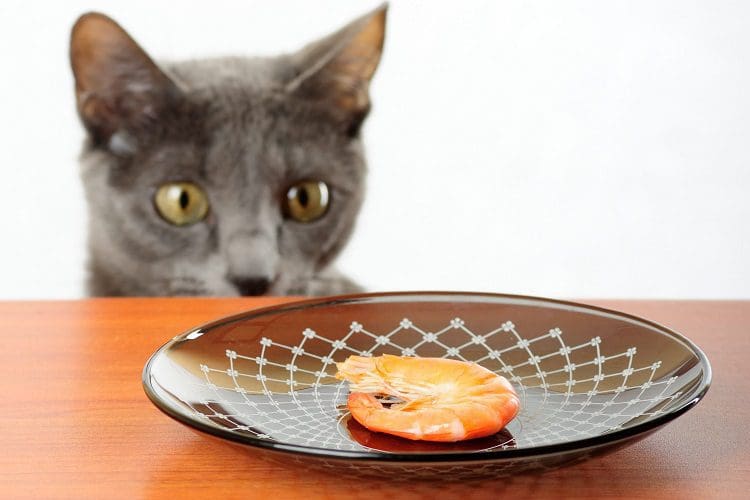
Introducing new foods into your cat’s diet can be tricky, but it doesn’t have to be.
Shrimp is a great source of protein and omega-3 fatty acids for cats, however, there are some risks associated with feeding shrimp to cats.
To ensure that you’re introducing shrimp safely into your cat’s diet, here are some tips to keep in mind.
Start With Small Amounts and Monitor Your Cat’s Reaction Closely
When introducing any new food into your cat’s diet, it’s important to start with small amounts and monitor their reaction closely.
Start by offering just a few pieces of cooked shrimp at first and watch for signs of an allergic reaction such as vomiting or diarrhea.
If they don’t show any adverse reactions after eating the shrimp then you can gradually increase the amount over time until they reach their desired serving size.
Don’t Replace Regular Meals With Shrimp Entirely
While adding seafood like shrimp into your cat’s regular meals is beneficial for them nutritionally, it shouldn’t replace their regular meals entirely as this could lead to nutritional deficiencies over time due to a lack of variety in their diets.
Aim for no more than 10% – 20% of total daily calories coming from seafood sources such as shrimp so that they still get all the other essential nutrients from other sources too.
Avoid Feeding Raw or Undercooked Shrimp to Your Cat
It may seem tempting but raw or undercooked seafood should never be fed to cats due to potential contamination with heavy metals and bacteria which could cause serious health issues if ingested by your pet.
Always make sure that the shrimp is cooked thoroughly before feeding it to your feline friend so that these risks are minimized as much as possible.
By following these simple tips when introducing shrimp into your cat’s diet, you can help ensure that both you and your furry companion stay safe while enjoying all the nutritional benefits that come along with this delicious treat.
Alternatives to Feeding Your Cat Shrimp
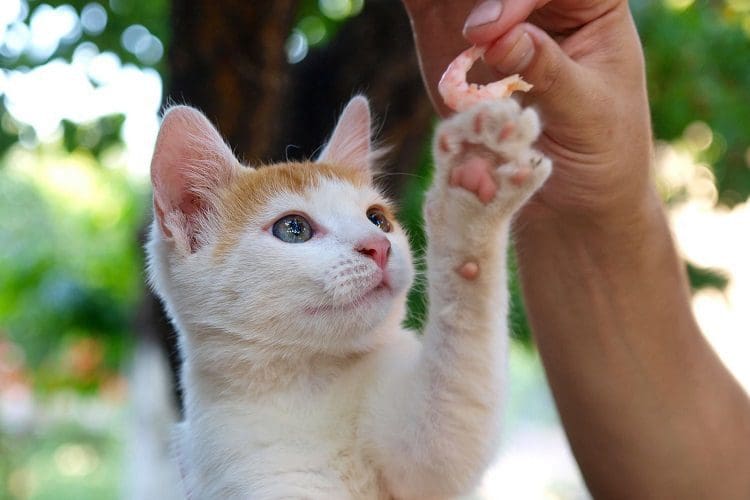
If you’re looking for alternatives to feeding your cat shrimp, there are plenty of options available. Fish is a great source of protein and omega-3 fatty acids, which can provide essential nutrients for cats.
Look for varieties like salmon, tuna, mackerel or sardines that have been specifically formulated for cats. Make sure the fish is cooked thoroughly before serving it to your pet.
Other sources of vitamins and minerals include lean meats such as chicken or turkey breast without skin or fat; eggs; yogurt; cottage cheese; and certain fruits and vegetables such as carrots, broccoli, apples or bananas (make sure they’re cut into small pieces).
These foods can be served either cooked or raw depending on your cat’s preference.
Homemade food options are also an excellent way to provide nutritious meals without having to resort to seafood.
Start by combining proteins with carbohydrates like brown rice and vegetables like peas, spinach or sweet potatoes in a blender until it forms a paste-like consistency.
Then add some oil (such as olive oil) for extra flavor and nutrition before transferring the mixture into an ice cube tray so that each portion is easily measured out when needed.
Avoid replacing regular meals entirely with these alternatives since cats need balanced diets just like humans do.
FAQs
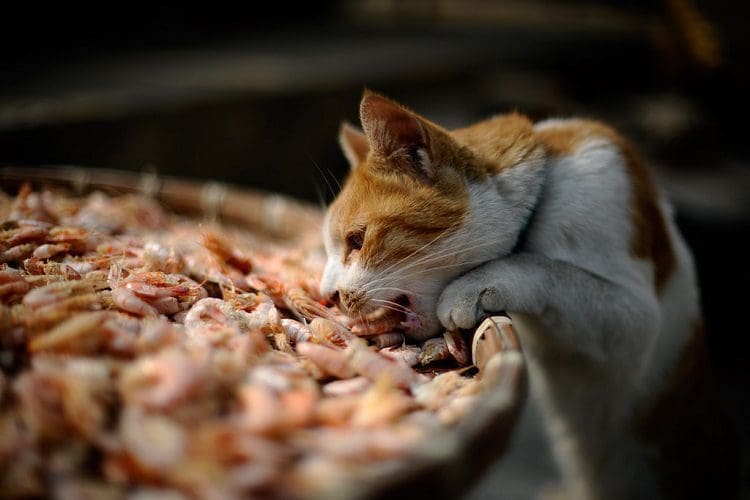
WHAT WILL HAPPEN IF A CAT EATS SHRIMP?
Eating shrimp can be dangerous for cats, as it may contain parasites and bacteria that could cause digestive upset or other health issues.
Shrimp shells are difficult to digest and can lead to intestinal blockages if not properly chewed before swallowing.
If your cat has eaten shrimp, monitor them closely for any signs of distress such as vomiting or diarrhea.
If you notice any symptoms, contact your veterinarian immediately for advice on how best to proceed.
CAN A CAT BE ALLERGIC TO SHRIMP?
Yes, cats can be allergic to shrimp. Allergies in cats are caused by an immune system reaction to a particular substance, such as seafood proteins found in shrimp.
Symptoms of a cat allergy to shrimp may include itching and skin irritation, sneezing or coughing, vomiting or diarrhea, and difficulty breathing.
If you suspect your cat has an allergy to shrimp it is important to seek veterinary care for proper diagnosis and treatment.
HOW OFTEN CAN CATS EAT SHRIMP?
Cats can eat shrimp in moderation. As with any food, it’s important to make sure the shrimp is cooked thoroughly before feeding it to your cat.
Shrimp should not be a major part of your cat’s diet, as too much seafood can lead to an imbalance of essential nutrients and minerals.
It’s best to feed your cat no more than one or two small pieces of shrimp per week as an occasional treat. Make sure you remove all shells and tails before giving them to your pet.
Conclusion
Cats can safely eat shrimp in moderation as long as it is prepared properly and introduced into their diet slowly.
While there are some potential risks associated with feeding your cat shrimp, the nutritional benefits outweigh them when done correctly.
If you’re still unsure if your cat should be eating shrimp, consult a veterinarian for advice specific to your pet’s needs.
Remember that no matter what food you decide to give your cat, always make sure they have access to plenty of fresh water and a balanced diet overall.
Resources:
